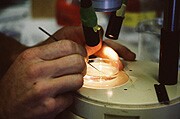
FRIDAY, Oct. 22 (HealthDay News) — An increasingly stubborn strain of methicillin-resistant Staphylococcus aureus, or MRSA, a common bacterial infection acquired in hospitals, has been identified in Ohio, according to research presented at the annual meeting of the Infectious Diseases Society of America.
The strain, ST239 MRSA, killed 22 percent of the people it infected within 30 days, the study found. It’s the first time that the strain, originally identified in Brazil, has been seen in the United States since the 1990s.
“It does have epidemic potential for outbreak,” the study’s co-author, Dr. Shu-Hua Wang, said. “It has increased capacity to cause invasive, serious infection.”
Wang’s group reported that 6.8 percent — or 77 — of 1,126 MRSA samples collected through the Ohio State University Health Network and seven rural hospitals in a three-year period from January 2007 to January 2010 were ST239.
Wang, who is an assistant professor of medicine at Ohio State, called for more genotyping of MRSA isolates.
A second study presented at the conference found that antibiotic prescriptions in the United States were much higher in the South than in the West, a finding that held for all types of antibiotics.
The average nationwide was 0.85 prescriptions per person in 2009, the study found. West Virginia had the highest rate (1.29 per person), followed by Kentucky, Tennessee, Louisiana, Alabama and Mississippi. The lowest prescription rates were seen in Alaska (0.52 prescriptions per person), followed by Oregon, Colorado, California and Washington state.
“The prescribing rate in the South was more than double the prescribing rate in the West,” said Dr. Lauri Hicks, with the U.S. Centers for Disease Control and Prevention, adding that the research team would be “exploring the reasons behind those differences.”
Health experts are interested in the rates, she said, “because antibiotic use is strongly linked to antibiotic resistance.”
Among other research being presented at the conference, which concludes Sunday in Vancouver, Canada: three new drugs appear to show promise in fighting MRSA and other bacteria when current antibiotics fail.
- Fusidic acid, which could fight S. aureus. “This is pretty exciting because it has no cross-resistance with any class of antibiotics so it could be used widely,” said Dr. Ronald N. Jones, chief executive of JMI Laboratories in North Liberty, Iowa, which makes the drug and funded the study being presented.
- JNJ-Q2. This potential agent belongs to a class of drugs known as fluoroquinolones and may be effective against S. aureus, including the methicillin-resistant form. “JNJ-Q2 was 16 times more potent than the existing marketed fluoroquinolones,” Jones said. The drug is moving into phase 2 and phase 3 trials, he said.
- A version of cephalosporin. It “may enable us to treat a broader spectrum of drug-resistant bacteria, although it probably won’t be on the market till 2013 or 2014,” Jones said.
Also being presented at the conference is a study involving a computer model that found that “universal contact precautions” — requiring anyone visiting a MRSA patient in the hospital to wear gloves and a gown — were more effective at preventing MRSA infection among patients in intensive-care units than were other strategies.
But the approach was expensive. The study’s lead author, Dr. Courtney A. Gidengil, an instructor in pediatrics at Children’s Hospital of Boston and Harvard Medical School, said that other strategies might be less effective but they are also less costly.
Another study presented at the conference found that carbapenem-resistant Enterobacteriaceae, or CRE, which carries a high mortality rate, is becoming more prevalent in the Chicago area.
More information
The CDC’s Get Smart campaign has more on when antibiotics work and when they don’t.

